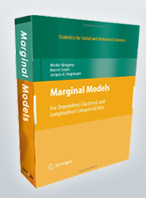 |
|
|||||||
 |
|
|
Marginal Models
for Dependent, Clustered, and Longitudinal Categorical Data Wicher Bergsma, Marcel Croon, Jacques Hagenaars From the reviews: “This is a well-written book on marginal models for categorical data using maximum likelihood methods… The authors successfully show the methodology of marginal modeling in an intuitive way for social and behavioral scientists…This book would be a fantastic reference for statisticians interested in learning more about repeated categorical response data analysis and marginal modeling beyond the familiar GEE procedure.” (Ivy Liu, Biometrics) From the back cover: In the social, behavioral, educational, economic, and biomedical sciences, data are often collected in ways that introduce dependencies in the observations to be compared. For example, the same respondents are interviewed at several occasions, several members of networks or groups are interviewed within the same survey, or, within families, both children and parents are investigated. Statistical methods that take the dependencies in the data into account must then be used, e.g., when observations at time one and time two are compared in longitudinal studies. At present, researchers almost automatically turn to multi-level models or to GEE estimation to deal with these dependencies. Despite the enormous potential and applicability of these recent developments, they require restrictive assumptions on the nature of the dependencies in the data. The marginal models of this book provide another way of dealing with these dependencies, without the need for such assumptions, and can be used to answer research questions directly at the intended marginal level. The maximum likelihood method, with its attractive statistical properties, is used for fitting the models. This book has mainly been written with applied researchers in mind. It includes many real world examples, explains the types of research questions for which marginal modeling is useful, and provides a detailed description of how to apply marginal models for a great diversity of research questions. All these examples are presented on the book's website (www.cmm.st), along with user friendly programs. Wicher Bergsma is Senior Lecturer at the London School of Economics and Political Science. His research interests are in statistics in general, but especially categorical data analysis, measurement of association and tests of independence, and statistical learning. Marcel Croon is associate professor at Tilburg University. He is especially interested in measurement problems, structural equation modeling, latent variables, and random effect models. Jacques Hagenaars is full professor at Tilburg University and at present chair of the board of IOPS, the Dutch PhD School for Sociometrics and Psychometrics. His main research interests are research designs, longitudinal research, categorical data analysis and latent variable models.
|
 |
|
|||
|
|
|
|||||||
|
|
|
|||||||
|
|
|
|||||||
|
|
|
|||||||
|
|
|
|||||||
 |
|
|||||||
|
|
||||||||
 |
|
|||||||
|
|
|
|||||||


